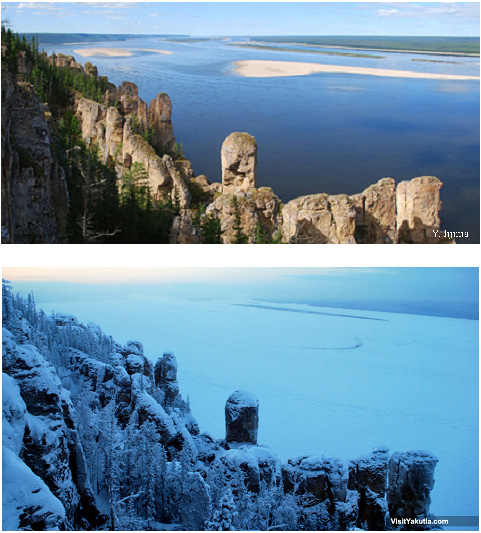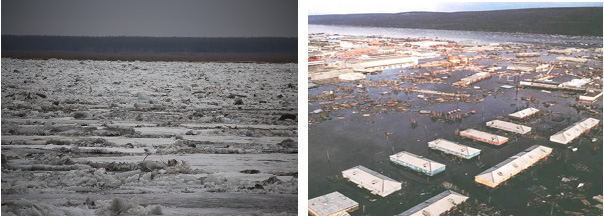Press Releases
February 25, 2016
JAMSTEC
Snowfall Induces Arctic River Ice Decrease
- Quantitative Evaluation of Global Warming Impacts on River Ice -
Overview
A research team led by Dr. Hotaek Park at Institute of Arctic Climate and Environment Research, the Japan Agency for Marine-Earth Science Technology (JAMSTEC: Asahiko Taira, President) revealed that global warming has resulted in decreases of river ice thickness in Arctic rivers with later fall freezeup and earlier spring breakup. It is based on analyses of numerical simulations with land and satellite observational data.
Arctic rivers start to freeze in autumn, forming a thin ice sheet. The river ice grows during winter season and melts in spring. During winter, the frozen rivers provide convenience of ice roads to local inhabitants. When snow melts, however, it sometimes causes spring floods due to ice jam*1, resulting in serious damages to local habitants. It is, therefore, very important for their lives to understand river ice changes associated with climate warming. It has been pointed out that recent climate change has coincided with apparent changes in Arctic river ice thickness and the seasonal phenology. However, quantitative assessment for the Arctic river ice has been limited to major rivers only with a few observations and model applications.
To quantify river ice changes over the Arctic rivers, the team used a land surface model*2 coupled with a river ice calculation model. As a result, the model simulation indicated decrease in the Arctic river ice thickness by 8cm for 31 years from 1979 to 2009. In addition, it was found that the ice thickness variation is strongly correlated with snow depth than air temperature. This relationship is more prominent in Siberian Rivers with increased snow depth. Furthermore, the simulations exhibited later fall freezeup and earlier spring breakup, consequently a longer seasonal ice-free period by nine days over the 1979-2009. The changes in river ice phenology significantly correlated with seasonal air temperature (SAT) warming.
The model results indicated that snow depth is an important factor for the Arctic river ice growth. These scientific findings will contribute to further understanding of the mechanism of the Arctic sea ice changes.
The above results were posted on Journal of Climate on February 25, 2016 (JST).
Title: Quantification of warming climate-induced changes in terrestrial Arctic river ice thickness and phenology
Authors: Hotaek Park1, Yasuhiro Yoshikawa2, Kazuhiro Oshima1, Youngwook Kim3, Thanh Ngo-Duc4, John S. Kimball3, Daqing Yang5
Affiliations:
- 1.
- Institute of Arctic Climate and Environment Research, JAMSTEC
- 2.
- Department of Civil and Environmental Engineering, Kitami Institute of Technology
- 3.
- Numerical Terradynamic Simulation Group, College of Forestry & Conservation, The University of Montana
- 4.
- Department of Meteorology and Climate Change, Hanoi College of Science, Vietnam National University
- 5.
- National Hydrology Research Centre, Environment Canada
*1 Ice jam
It is a phenomenon of an ice blockage on a river that restricts the river water flow to downstream during ice breakup. Depending on ice thickness and ice jam scale, it could cause heavy flood in the upward areas during thawing weather.
*2 Land surface model (CHANGE)
It is a process-based model that calculates fluxes of water, heat and CO2 in the atmosphere, vegetation and soil system. By incorporating energy balance, plant ecology and physiological processes, photosynthesis, and hydrological processes into the model, CHANGE used in this study can quantitatively evaluate land system interactions and feedback that occur when processes or elements change.

Photo 1: Lena River in summer (upper) and winter (bottom). During winter, the frozen river is used for road, while ships are used for transportation during summer.

Photo 2 (Left) :Lena river with ice break (Right): Ice jam flood hit Lensk in May 2001 (photo from State Hydrological Institute)
In May 2001, heavy flooding hit Lensk (population: 28,000), the fourth biggest city in the Sakha (Yakutia) Republic, the Russian Federation. Because the water level rose 12m, the city was underwater. It resulted in the damages of 4 billion rubles (about 7.1 billion yen) for the city and 7 billion rubles (about 11.1 billion yen) for the whole Sakha (Yakutia) Republic, which was equivalent to 21% of the annual budget of the country.

Figure 1: The seven major Arctic watersheds and river systems used for model evaluations in this study. Gray areas represent other remaining Arctic watersheds.

Figure 2: Time series of anomalous averaged river ice thickness derived from model simulated maximum ice thickness (top), freezing index (Oct-Apr, middle), and simulated winter mean snow depth (SND) (Jan-Mar, bottom) over the Arctic rivers. Annual anomalies of the variables represent differences from the 1979-2009 period means.
Decrease in river ice thickness seems to be affected by temperature rise, however, river ice thickness around 1990 and 2000 is negatively correlated with snow depth (SND), which suggests that snow cover influences time series changes of ice thickness.

Figure 3: Sensitivity of estimated maximum river-ice thickness to changes in overlying snowfall (SND, circles) and surface air temperature (SAT, squares) during October-March.
River ice thickness is more sensitive to snow cover changes than temperature.
The simulation condition was set based on fluctuation ranges of 3 degrees in temperature and 30% in snow cover. The change of ice-thickness for 10% increase/decrease of snow cover is equivalent to temperature change of 2 degrees. It means even a small changes of snow cover could give significant impacts on river ice thickness.

Figure 4: Time series of anomalous annual freezing index (top), snow depth (SND) from January-March (middle), and maximum river ice thickness (bottom) in Siberia (60-73°N, 90-135°E, left) and North America (60-73°N, 215-260°E, right) Rivers.
The annual values of snow depth (SND) and maximum ice thickness represent model simulations. In the figures, the light gray lines denote annual values; black lines denote three-year-averages, and black dotted lines represent trends for the 1979-2009 simulation record.
Snow depth (SND) tends to be increasing in both areas, while river ice in North America is thicker than that in Siberia. Decrease of river ice thickness in Siberia is influenced by higher insulation of deeper snow depth.

Figure 5: Time series of anomalous ice breakup date (top), freezeup date(middle), and ice-free duration in the Arctic rivers. Annual anomalies for freezing index and snow depth represent differences from the 1979-2009 period means. Dotted lines represent the long-term trend over the 1979-2009 record. River ice breakup is becoming earlier in the most part of the Arctic region, while ice freezeup is delayed, consequently shortening river ice duration.

Figure 6: Trend of period without river ice formation between 1979 and 2009 calculated by the land surface model. In most areas excluding some in North America, the river ice duration is shortening, of which trend is significantly prominent in West Siberia.

Figure 7: Results of sensitivity experiments using land surface model for ice breakup date in Siberia (shown in black) and North America (shown in gray) by changing temperature (SAT) during winter (October-March) and spring (April-May), and snow fall (SND) conditions.
In particular, spring temperature changes significantly affect ice breakup. If spring temperature is lower, ice breakup delays by five days. On the contrary, higher spring temperature results in earlier ice breakup by six days (shown in dark blues). These changes are more prominent in Siberia than North America. On the other hand, if the temperature condition in spring remains the same, increase/decrease in snow depth (SND) does not largely affect ice breakup (as shown in green). These results revealed that spring temperature is a major factor affecting ice breakup period.
Contacts:
- JAMSTEC
- (For this study)
- Hotaek Park, Senior Scientist, Arctic Ocean and Climate System Research Unit, Institute of Arctic Climate and Environment Research
- (For press release)
- Hiroyasu Matsui, Press Division, Public Relations Department